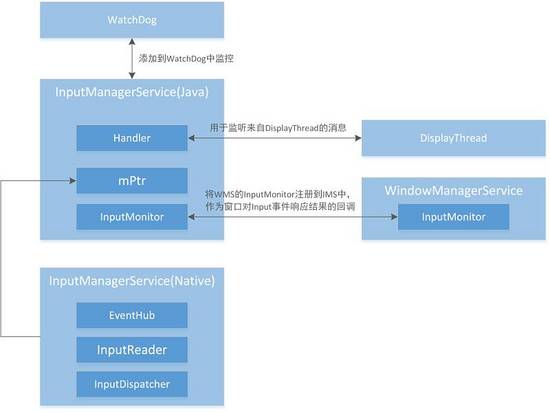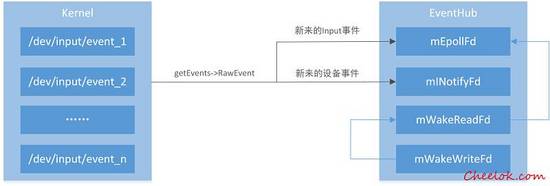本文主要从系统源码的角度带你一步步了解Android Input子系统。
从我个人的理解来看,Android的Input系统其实就是系统级的事件处理、分发框架,它需要的功能模块大致有:事件读取、事件分类、事件分发。那么我们就从整个Input系统的输入源入手,了解事件是如何被输入到Input系统中的。
在看代码前我们先想一想,如果要我们设计一个事件分发框架的输入读取模块,要考虑到哪些子模块:
- 事件生成模块(当用户对设备进行操作产生InputEvent,硬件产生中断将事件交给驱动,驱动交给内核,内核交给framework)
- 事件监听模块(这里就很像设计一个服务器,为了及时响应来自客户端的请求,则需要启动一个线程监听)
- 事件读取模块
- 事件分发模块
那么现在我们最起码可以知道整个学习的起点了,就是Input系统中,负责监听的线程是谁,监听的过程中它们做了什么。 在开始之前,给大家分享一张我根据本文内容画的图:
InputManagerService初始化概览
首先,有几点共识我们都可以达成:
- Android Framework层的Service(Java)都是由system_server进程创建的(由于没有fork,因此都运行在system_server进程中)
- Service创建后就会交给运行在system_server进程中的ServiceManager管理。
因此对于InputManagerService的创建,我们可以在SystemServer的startOtherServices()方法中找到,该方法做了以下事情:
- 创建InputManagerService对象
- 将它交给ServiceManager管理
- 将WindowManagerService的InputMonitor注册到InputManagerService中作为窗口响应事件后的回调
- 完成以上工作后启动InputManagerService。
- SystemServer.javastartOtherServices(){
- ……
- inputManager = new InputManagerService(context);
- ……
- inputManager.setWindowManagerCallbacks(wm.getInputMonitor());
- inputManager.start();
- ……
- }
接下来我们就逐部分学习相应的处理。
InputManagerService对象的创建
创建InputManagerService对象时会完成以下工作:
- 创建一个负责处理DisplayThread线程中的Message的Handler
- 调用nativeInit初始化native层的InputManagerService,初始化的时候传入了DisplayThread的消息队列
- 用mPtr保存native层的InputManagerService
- 初始化完成后将Service添加到LocalServices,通过Map以键值对的形式存储
- InputManagerService.javapublic InputManagerService(Context context) { this.mContext = context; this.mHandler = new InputManagerHandler(DisplayThread.get().getLooper());
- mUseDevInputEventForAudioJack =
- context.getResources().getBoolean(R.bool.config_useDevInputEventForAudioJack);
- Slog.i(TAG, "Initializing input manager, mUseDevInputEventForAudioJack="
- + mUseDevInputEventForAudioJack);
- mPtr = nativeInit(this, mContext, mHandler.getLooper().getQueue());
- LocalServices.addService(InputManagerInternal.class, new LocalService());
- }
这里可能有人就会问了,为什么InputManagerService要和DisplayThread绑定在一起?大家不妨想想,InputEvent无论如何被获取、归类、分发,最终还是要被处理,也就意味着最终它的处理结果都要在UI上体现,那么InputManagerService自然要选择和UI亲近一些的线程在一起了。
但是问题又来了,应用都是运行在自己的主线程里的,难道InputManagerService要一个个绑定么,还是一个个轮询?这些做法都太过低效,那换个办法,可不可以和某个管理或非常亲近所有应用UI的线程绑定在一起呢?
答案是什么,我在这里先不说,大家可以利用自己的知识想想。
初始化native层的InputManagerService
在nativeInit函数中,将Java层的MessageQueue转换为native层的MessageQueue,然后再取出Looper用于NativeInputManager的初始化。可见这里的重头戏就是NativeInputManager的创建,这个过程做了以下事情:
- 将Java层的Context和InputManagerService转换为native层的Context和InputManagerService存储在mContextObj和mServiceObj中
- 初始化变量
- 创建EventHub
- 创建InputManager
- com_android_server_input_InputManagerService.cpp
- NativeInputManager::NativeInputManager(jobject contextObj,
- jobject serviceObj, const sp<Looper>& looper) :
- mLooper(looper), mInteractive(true) {
- JNIEnv* env = jniEnv();
- mContextObj = env->NewGlobalRef(contextObj);
- mServiceObj = env->NewGlobalRef(serviceObj);
- { AutoMutex _l(mLock);
- mLocked.systemUiVisibility = ASYSTEM_UI_VISIBILITY_STATUS_BAR_VISIBLE;
- mLocked.pointerSpeed = 0;
- mLocked.pointerGesturesEnabled = true;
- mLocked.showTouches = false;
- }
- mInteractive = true;
- sp<EventHub> eventHub = new EventHub();
- mInputManager = new InputManager(eventHub, this, this);
- }
EventHub
看到这里很多人就会想,EventHub是什么?取英语释义来看,它的意思是事件枢纽。我们在文章开头的时候也提到过,Input系统的事件来源于驱动/内核,那么我们可以猜测EventHub是处理来自驱动/内核的元事件的枢纽。接下来就在源码中验证我们的想法吧。
EventHub的创建过程中做了以下事情:
- 创建mEpollFd用于监听是否有数据(有无事件)可读
- 创建mINotifyFd将它注册到DEVICE_PATH(这里路径就是/dev/input)节点,并将它交给内核用于监听该设备节点的增删数据事件。那么只要有数据增删的事件到来,epoll_wait()就会返回,使得EventHub能收到来自系统的通知,并获取事件的详细信息
- 调用epoll_ctl函数将mEpollFd和mINotifyFd注册到epoll中
- 定义int wakeFd[2]作为事件传输管道的读写两端,并将读端注册到epoll中让mEpollFd监听
- EventHub.cpp
- EventHub::EventHub(void) :
- mBuiltInKeyboardId(NO_BUILT_IN_KEYBOARD), mNextDeviceId(1), mControllerNumbers(),
- mOpeningDevices(0), mClosingDevices(0),
- mNeedToSendFinishedDeviceScan(false),
- mNeedToReopenDevices(false), mNeedToScanDevices(true),
- mPendingEventCount(0), mPendingEventIndex(0), mPendingINotify(false) {
- acquire_wake_lock(PARTIAL_WAKE_LOCK, WAKE_LOCK_ID);
- mEpollFd = epoll_create(EPOLL_SIZE_HINT);
- LOG_ALWAYS_FATAL_IF(mEpollFd < 0, "Could not create epoll instance. errno=%d", errno);
- mINotifyFd = inotify_init();
- int result = inotify_add_watch(mINotifyFd, DEVICE_PATH, IN_DELETE | IN_CREATE);
- ……
- result = epoll_ctl(mEpollFd, EPOLL_CTL_ADD, mINotifyFd, &eventItem);
- ……
- int wakeFds[2];
- result = pipe(wakeFds);
- ……
- mWakeReadPipeFd = wakeFds[0];
- mWakeWritePipeFd = wakeFds[1];
- result = fcntl(mWakeReadPipeFd, F_SETFL, O_NONBLOCK);
- ……
- result = fcntl(mWakeWritePipeFd, F_SETFL, O_NONBLOCK);
- ……
- result = epoll_ctl(mEpollFd, EPOLL_CTL_ADD, mWakeReadPipeFd, &eventItem);
- ……
- }
那么这里抛出一个问题:为什么要把管道的读端注册到epoll中?假如EventHub因为getEvents读不到事件而阻塞在epoll_wait()里,而我们没有绑定读端的话,我们要怎么唤醒EventHub?如果绑定了管道的读端,我们就可以通过向管道的写端写数据从而让EventHub因为得到管道写端的数据而被唤醒。
InputManager的创建
接下来继续说InputManager的创建,它的创建就简单多了,创建一个InputDispatcher对象用于分发事件,一个InputReader对象用于读事件并把事件交给InputDispatcher分发,,然后调用initialize()初始化,其实也就是创建了InputReaderThread和InputDispatcherThread。
- InputManager.cpp
- InputManager::InputManager( const sp<EventHubInterface>& eventHub, const sp<InputReaderPolicyInterface>& readerPolicy, const sp<InputDispatcherPolicyInterface>& dispatcherPolicy) {
- mDispatcher = new InputDispatcher(dispatcherPolicy);
- mReader = new InputReader(eventHub, readerPolicy, mDispatcher);
- initialize();
- }void InputManager::initialize() {
- mReaderThread = new InputReaderThread(mReader);
- mDispatcherThread = new InputDispatcherThread(mDispatcher);
- }
InputDispatcher和InputReader的创建都相对简单。InputDispatcher会创建自己线程的Looper,以及设置根据传入的dispatchPolicy设置分发规则。InputReader则会将传入的InputDispatcher封装为监听对象存起来,做一些数据初始化就结束了。
至此,InputManagerService对象的初始化就完成了,根据开头说的,接下来就会调用InputManagerService的start()方法。
监听线程InputReader和InputDispatcher的启动
在start()方法中,做了以下事情:
- 调用nativeStart方法,其实就是调用InputManager的start()方法
- 将InputManagerService交给WatchDog监控
- 注册触控点速度、显示触控的观察者,并注册广播监控它们
- 主动调用updateXXX方法更新(初始化)
- InputManagerService.javapublic void start() {
- Slog.i(TAG, "Starting input manager");
- nativeStart(mPtr); // Add ourself to the Watchdog monitors.
- Watchdog.getInstance().addMonitor(this);
- registerPointerSpeedSettingObserver();
- registerShowTouchesSettingObserver();
- registerAccessibilityLargePointerSettingObserver();
- mContext.registerReceiver(new BroadcastReceiver() { @Override
- public void onReceive(Context context, Intent intent) {
- updatePointerSpeedFromSettings();
- updateShowTouchesFromSettings();
- updateAccessibilityLargePointerFromSettings();
- }
- }, new IntentFilter(Intent.ACTION_USER_SWITCHED), null, mHandler);
- updatePointerSpeedFromSettings();
- updateShowTouchesFromSettings();
- updateAccessibilityLargePointerFromSettings();
- }
显而易见这里最值得关注的就是InputManager的start()方法了,可惜这个方法并不值得我们如此关心,因为它做的事情很简单,就是启动InputDispatcherThread和InputReaderThread开始监听。
- status_t InputManager::start() {
- status_t result = mDispatcherThread->run("InputDispatcher", PRIORITY_URGENT_DISPLAY); if (result) {
- ALOGE("Could not start InputDispatcher thread due to error %d.", result); return result;
- }
- result = mReaderThread->run("InputReader", PRIORITY_URGENT_DISPLAY); if (result) {
- ALOGE("Could not start InputReader thread due to error %d.", result);
- mDispatcherThread->requestExit(); return result;
- } return OK;
- }
那么InputReaderThread线程是怎么和EventHub关联起来的呢?
对于InputReadThread:
- 启动后循环执行mReader->loopOnce()
- loopOnce()中会调用mEventHub->getEvents读取事件
- 读到了事件就会调用processEventsLocked处理事件
- 处理完成后调用getInputDevicesLocked获取输入设备信息
- 调用mPolicy->notifyInputDevicesChanged函数利用InputManagerService的代理通过Handler发送MSG_DELIVER_INPUT_DEVICES_CHANGED消息,通知输入设备发生了变化
- ***调用mQueuedListener->flush(),将事件队列中的所有事件交给在InputReader中注册过的InputDispatcher
- bool InputReaderThread::threadLoop() {
- mReader->loopOnce(); return true;
- }void InputReader::loopOnce() {
- ……
- size_t count = mEventHub->getEvents(timeoutMillis, mEventBuffer, EVENT_BUFFER_SIZE);
- { // acquire lock
- AutoMutex _l(mLock);
- mReaderIsAliveCondition.broadcast(); if (count) {
- processEventsLocked(mEventBuffer, count);
- }
- …… if (oldGeneration != mGeneration) {
- inputDevicesChanged = true;
- getInputDevicesLocked(inputDevices);
- }
- } // release lock
- // Send out a message that the describes the changed input devices.
- if (inputDevicesChanged) {
- mPolicy->notifyInputDevicesChanged(inputDevices);
- }
- ……
- mQueuedListener->flush();
- }
至此,Input系统有关事件输入模块的学习就结束了,在后续的文章中会继续学习Input系统的事件归类、分发流程,感兴趣的朋友可以留意关注。































